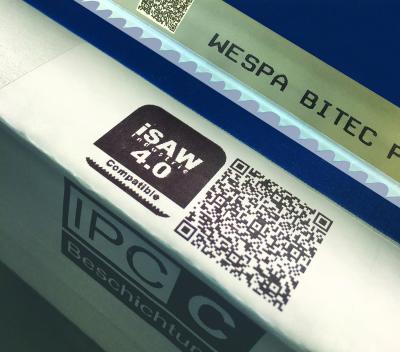
Simonds Saw has announced hat its European partner, WESPA, has introduced the ability to produce instant "blade-to-machine" data transfer of machine-specific cutting parameters for its Individual Performance Cutting (IPC) custom bandsaw blades program. This instant data transfer technology directly supports the Industry 4.0 concept.
By using a mobile device and scanning a QR code on the saw blade or blade box, saw operators can point the scan to the machine to transfer a complete, unique data set so the machine can begin cutting. "We were excited to have introduced our instant blade-to-machine technology at EMO this year, where it was extremely well received." said David Miles, president of Simonds Saw.
Industry 4.0 is a manufacturing trend designed to increase automation and data exchange from machine to machine. Using this technology, machines share and process data, adapting and recalibrating as needed to maximize performance. Industry 4.0 is essentially "artificial intelligence meets manufacturing."
The IPC Solution from Simonds Saw uses a Band Saw Blade Simulator Program to improve sawing productivity up to 60 percent by significantly improving the performance, productivity and return on investment of a user's sawing operation. The Simulator enables a user to model their sawing application and compare the results obtained with conventional saw technology to unique blade/ tooth configurations designed specifically by Simonds/WESPA for the user’s application.
Contact Details
Related Glossary Terms
- bandsaw
bandsaw
Machine that utilizes an endless band, normally with serrated teeth, for cutoff or contour sawing. See saw, sawing machine.
- bandsaw blade ( band)
bandsaw blade ( band)
Endless band, normally with serrated teeth, that serves as the cutting tool for cutoff or contour band machines.
- sawing
sawing
Machining operation in which a powered machine, usually equipped with a blade having milled or ground teeth, is used to part material (cutoff) or give it a new shape (contour bandsawing, band machining). Four basic types of sawing operations are: hacksawing (power or manual operation in which the blade moves back and forth through the work, cutting on one of the strokes); cold or circular sawing (a rotating, circular, toothed blade parts the material much as a workshop table saw or radial-arm saw cuts wood); bandsawing (a flexible, toothed blade rides on wheels under tension and is guided through the work); and abrasive sawing (abrasive points attached to a fiber or metal backing part stock, could be considered a grinding operation).
- sawing machine ( saw)
sawing machine ( saw)
Machine designed to use a serrated-tooth blade to cut metal or other material. Comes in a wide variety of styles but takes one of four basic forms: hacksaw (a simple, rugged machine that uses a reciprocating motion to part metal or other material); cold or circular saw (powers a circular blade that cuts structural materials); bandsaw (runs an endless band; the two basic types are cutoff and contour band machines, which cut intricate contours and shapes); and abrasive cutoff saw (similar in appearance to the cold saw, but uses an abrasive disc that rotates at high speeds rather than a blade with serrated teeth).
